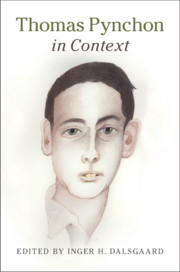Book contents
- Thomas Pynchon in Context
- Thomas Pynchon in Context
- Copyright page
- Contents
- Contributors
- Abbreviations
- Chronology
- Introduction
- Part I Times and Places
- Chapter 1 Biography
- Chapter 2 Letters and Juvenilia
- Chapter 3 Nonfiction
- Chapter 4 East Coast
- Chapter 5 West Coast
- Chapter 6 Europe and Asia
- Chapter 7 Africa and Latin America
- Chapter 8 Geographies and Mapping
- Chapter 9 The Eighteenth Century
- Chapter 10 The Nineteenth Century
- Chapter 11 The Twentieth Century
- Chapter 12 The Twenty-First Century
- Chapter 13 History and Metahistory
- Part II Culture, Politics, and Society
- Part III Approaches and Readings
- Further Reading
- Index
Chapter 9 - The Eighteenth Century
from Part I - Times and Places
Published online by Cambridge University Press: 31 May 2019
- Thomas Pynchon in Context
- Thomas Pynchon in Context
- Copyright page
- Contents
- Contributors
- Abbreviations
- Chronology
- Introduction
- Part I Times and Places
- Chapter 1 Biography
- Chapter 2 Letters and Juvenilia
- Chapter 3 Nonfiction
- Chapter 4 East Coast
- Chapter 5 West Coast
- Chapter 6 Europe and Asia
- Chapter 7 Africa and Latin America
- Chapter 8 Geographies and Mapping
- Chapter 9 The Eighteenth Century
- Chapter 10 The Nineteenth Century
- Chapter 11 The Twentieth Century
- Chapter 12 The Twenty-First Century
- Chapter 13 History and Metahistory
- Part II Culture, Politics, and Society
- Part III Approaches and Readings
- Further Reading
- Index
Summary
“’Tis the Age of Reason, Rff?” (MD 22), declares the Learnèd English Dog in Mason & Dixon (1997), and indeed the eighteenth century was marked in the Western world by a belief in “progress” in science, medicine, and the arts. Human life can be bettered, goes this Enlightenment thinking, by using reason to understand and improve upon nature through “establish[ing] rational and standardized ways to study and manage nature and society.” Overseen by professional organizations like the Royal Society in London and the Academy of Sciences in Paris, Euro-American ideology sought to “discover” the fixed “laws” of nature, which is to say observe and classify into categories the natural, political, and social world, all under the banner of “science”; in “Is It O.K. to Be a Luddite?” Pynchon remarks of this era that the laws of nature became “strictly formulated.” Some high points of this trust in progress were the establishment of professional scientific organizations themselves; Fahrenheit’s mercury thermometer; Franklin’s experiments with and harnessing of electricity; radical improvements in time-keeping and geographical boundary-making; calendar reform; and the Linnaean classification of species. Mason & Dixon’s mechanical duck, built by Jacques de Vaucanson, is a fictionalized enhancement of one such experiment: The Duck evolves beyond machinery, gains life and sentience, and falls in love with and stalks Chef Armand. In historical fact, Vaucanson built several mechanical ducks; like others in Europe and America, he built automata to experiment with the growing body of knowledge about anatomy, hydraulics, and pneumatics, to educate and to entertain people at traveling exhibits. Such was the belief in progress during the era of Enlightenment that Vaucanson hoped to create a duck that would in fact have something like “life,” if not sentience.
- Type
- Chapter
- Information
- Thomas Pynchon in Context , pp. 74 - 81Publisher: Cambridge University PressPrint publication year: 2019



